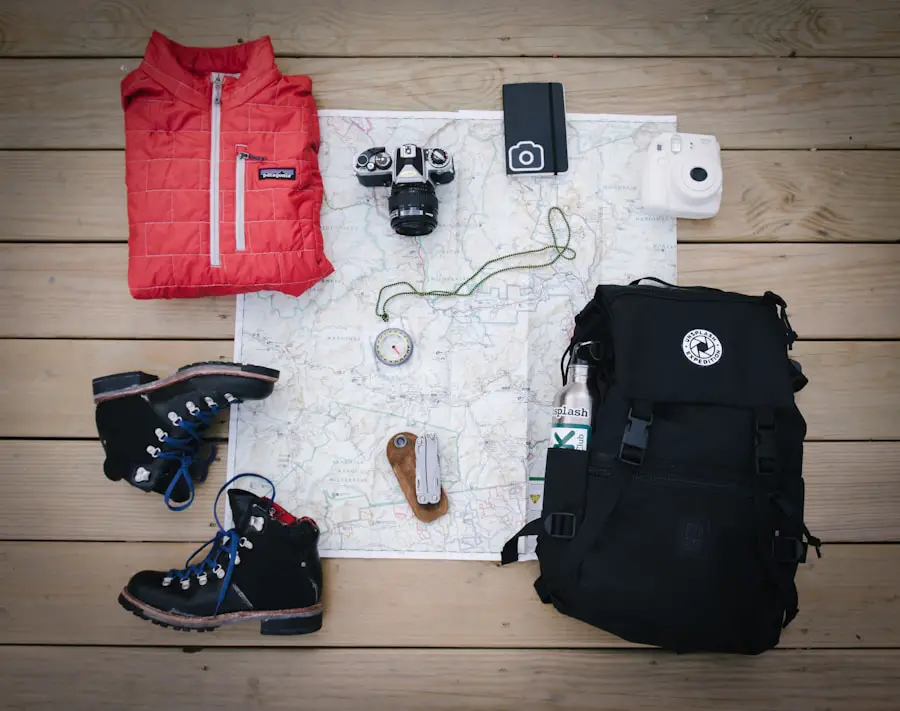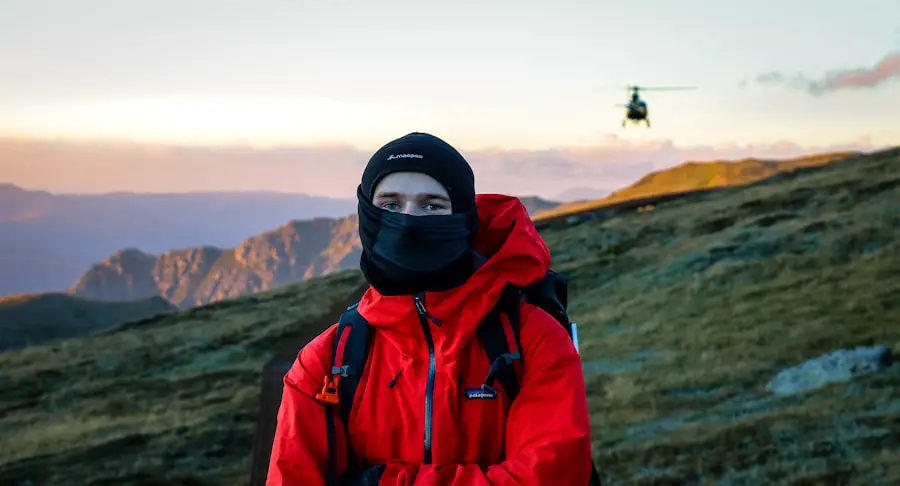Layering is a fundamental principle in outdoor clothing that allows hikers to adapt to changing conditions while maintaining comfort. The concept revolves around wearing multiple layers of clothing, each serving a specific purpose. The base layer, typically made from moisture-wicking materials, sits closest to the skin and is designed to pull sweat away from the body.
This is crucial during physical exertion, as it helps regulate body temperature and prevents the chill that can occur when sweat cools on the skin. Fabrics such as merino wool or synthetic blends are popular choices for base layers due to their breathability and quick-drying properties. The middle layer, often referred to as the insulation layer, provides warmth.
This layer can be made from fleece, down, or synthetic insulation materials. Fleece is lightweight and offers excellent breathability, making it a versatile option for varying temperatures. Down insulation, while incredibly warm, can lose its insulating properties when wet, so it’s essential to consider the weather conditions when choosing this layer.
The outer layer, or shell layer, serves as a protective barrier against wind and rain. Waterproof and windproof jackets are essential for keeping the elements at bay, ensuring that the inner layers remain dry and effective. By combining these layers thoughtfully, hikers can easily adjust their clothing to match the intensity of their activity and the conditions they encounter.
Key Takeaways
- Layering is key for comfort and versatility on a day hike
- Choose the right fabrics for moisture-wicking and breathability
- Wear footwear that provides support and traction on different terrains
- Protect yourself from the elements with sunblock, hats, and rain gear
- Pack essentials like water, snacks, a map, and a first aid kit for a day hike
Choosing the Right Fabrics
Selecting the appropriate fabrics for hiking attire is critical for ensuring comfort and performance on the trail. Natural fibers like cotton may seem appealing due to their softness, but they absorb moisture and take a long time to dry, which can lead to discomfort and chills in cooler conditions. Instead, synthetic fabrics such as polyester and nylon are often preferred for their moisture-wicking capabilities and quick-drying properties.
These materials help keep the body dry by drawing sweat away from the skin and allowing it to evaporate quickly. Merino wool has gained popularity among outdoor enthusiasts for its unique properties. Unlike traditional wool, which can be itchy and uncomfortable, merino wool is soft against the skin and offers excellent thermal regulation.
It can keep you warm in cold conditions while remaining breathable in warmer weather. Additionally, merino wool has natural odor-resistant qualities, making it an ideal choice for multi-day hikes where laundry facilities may not be available. When selecting hiking gear, it’s essential to consider not only the fabric type but also its weight and stretchability.
Lightweight fabrics are preferable for long hikes as they reduce bulk and allow for greater freedom of movement.
Footwear for Support and Traction

Footwear is one of the most critical components of any hiking outfit, as it directly impacts comfort, safety, and performance on the trail. Hiking boots or shoes should provide adequate support to prevent injuries such as sprains or blisters. A well-fitted boot with proper arch support can make a significant difference during long treks over uneven terrain.
Many hikers opt for mid- or high-cut boots that offer additional ankle support, particularly when navigating rocky paths or steep inclines. Traction is another vital aspect of hiking footwear. The outsoles of hiking boots are typically made from rubber compounds designed to provide grip on various surfaces, including wet rocks and muddy trails.
Vibram soles are a popular choice among outdoor enthusiasts due to their durability and superior traction capabilities. Additionally, hikers should consider the tread pattern of their footwear; deeper lugs can enhance grip on loose or slippery surfaces. It’s also essential to break in new footwear before embarking on a long hike to avoid discomfort and blisters.
Protecting Yourself from the Elements
| Element | Protection |
|---|---|
| Sun | Use sunscreen with SPF 30 or higher |
| Rain | Wear a waterproof jacket or coat |
| Wind | Wear windproof clothing and use a scarf or face mask |
| Cold | Dress in layers and wear insulated clothing |
| Heat | Stay hydrated and wear light, breathable clothing |
When venturing into nature, being prepared for various weather conditions is crucial for both safety and enjoyment. Rain can appear unexpectedly in many regions, so having a reliable waterproof jacket is essential. Look for jackets with features such as adjustable hoods, ventilation zippers, and sealed seams to ensure maximum protection against moisture while allowing breathability during physical activity.
Additionally, waterproof pants can provide an extra layer of protection against rain and mud. Sun exposure is another element that hikers must consider. Wearing a wide-brimmed hat can shield your face and neck from harmful UV rays while also keeping you cool.
Lightweight, long-sleeved shirts made from breathable fabrics can offer additional sun protection without causing overheating. In areas with high altitudes or reflective surfaces like snow or water, applying sunscreen with a high SPF is vital to prevent sunburn. By taking these precautions against the elements, hikers can focus on enjoying their adventure rather than worrying about discomfort or health risks.
Accessories for Sun Protection
In addition to clothing designed for sun protection, various accessories can enhance your defense against UV rays while hiking. Sunglasses with UV protection are essential for safeguarding your eyes from harmful rays that can lead to long-term damage. Look for sunglasses labeled with 100% UV protection or UV400 rating to ensure they block both UVA and UVB rays effectively.
Polarized lenses can also reduce glare from reflective surfaces like water or snow, improving visibility on bright days. Another accessory that should not be overlooked is a good quality sun hat. A hat with a wide brim not only protects your face but also provides shade for your neck and ears—areas often overlooked when applying sunscreen.
Some hats come with built-in UPF (Ultraviolet Protection Factor) ratings that indicate their effectiveness in blocking UV rays. Additionally, consider using a bandana or neck gaiter that can be soaked in water for cooling relief during hot hikes; this versatile accessory can also be used as a face covering if needed.
Packing Essentials for a Day Hike

When preparing for a day hike, packing efficiently is key to ensuring you have everything you need without being weighed down by unnecessary items.
A well-structured daypack is essential; it should be comfortable to wear and have enough capacity to hold your gear without being overly bulky. Start by packing essentials such as water—hydration systems or water bottles are both viable options—and snacks that provide energy without taking up too much space.First aid kits are another crucial component of your hiking gear; they should include items like adhesive bandages, antiseptic wipes, pain relievers, and any personal medications you may need during your hike. A multi-tool or knife can also come in handy for various tasks along the trail, from food preparation to gear repairs. Additionally, consider packing a lightweight emergency blanket or bivy sack in case of unexpected situations where you may need to spend more time outdoors than planned.
Dressing for Variable Weather Conditions
Weather conditions can change rapidly in many hiking environments, making it essential to dress appropriately for variable climates. One effective strategy is to check weather forecasts before heading out but also prepare for unexpected changes by bringing extra layers or gear that can accommodate different scenarios. For instance, if rain is forecasted but conditions are currently dry, packing a lightweight rain jacket in your daypack ensures you’re ready if the skies open up unexpectedly.
In cooler climates or during early morning hikes when temperatures are low, starting with a heavier base layer may be beneficial; as the day warms up, you can shed layers accordingly. Conversely, if you’re hiking in warmer weather but expect temperatures to drop in the evening or at higher elevations, wearing breathable fabrics that allow moisture to escape while still providing warmth when needed is crucial. This adaptability not only enhances comfort but also ensures safety throughout your hike.
Tips for Staying Comfortable on the Trail
Maintaining comfort on the trail involves more than just choosing the right clothing; it encompasses various practices that contribute to an enjoyable hiking experience. Staying hydrated is paramount; dehydration can lead to fatigue and decreased performance. Carrying an adequate supply of water and taking regular sips throughout your hike helps maintain energy levels and overall well-being.
Another important aspect of comfort is pacing yourself according to your fitness level and the difficulty of the trail. It’s easy to get caught up in the excitement of exploring new terrain but pushing too hard can lead to exhaustion or injury. Taking breaks at regular intervals allows you to rest your muscles and enjoy the scenery without feeling rushed.
Additionally, paying attention to your body’s signals—such as fatigue or discomfort—can help you make necessary adjustments during your hike, ensuring that you remain comfortable and safe throughout your outdoor adventure. By understanding these principles of layering, fabric selection, footwear choices, weather protection strategies, accessory use, packing essentials, dressing techniques for variable conditions, and comfort tips on the trail, hikers can enhance their outdoor experiences significantly. Each element plays a vital role in creating an enjoyable hiking journey that allows individuals to connect with nature while prioritizing safety and comfort.
When planning what to wear hiking in 60-degree weather, it’s important to consider all aspects of your outdoor adventure. In addition to clothing, it’s also crucial to pack the right gear for your trip. One essential item to bring along is a portable white noise machine for travel, which can help you relax and sleep better in unfamiliar environments. This article on the best portable white noise machines for travel here provides great recommendations for those looking to enhance their outdoor experience with a good night’s sleep.
Love travel? Join Our Facebook Community For More Tips.
FAQs
What should I wear for hiking in 60 degree weather?
In 60 degree weather, it’s best to wear moisture-wicking base layers, a lightweight long-sleeve shirt, and a breathable and water-resistant jacket.
What type of pants are suitable for hiking in 60 degree weather?
For hiking in 60 degree weather, it’s recommended to wear lightweight and breathable hiking pants or convertible pants that can be adjusted as the temperature changes.
What kind of footwear is appropriate for hiking in 60 degree weather?
For hiking in 60 degree weather, it’s best to wear sturdy and comfortable hiking boots or trail shoes with good traction to navigate various terrains.
What accessories should I bring for hiking in 60 degree weather?
It’s important to bring a wide-brimmed hat, sunglasses, sunscreen, and a lightweight backpack with essentials such as water, snacks, a map, and a first aid kit.
Are there any specific considerations for hiking in 60 degree weather?
In 60 degree weather, it’s important to be prepared for potential changes in temperature, so layering is key. Additionally, it’s important to stay hydrated and protect yourself from the sun.
